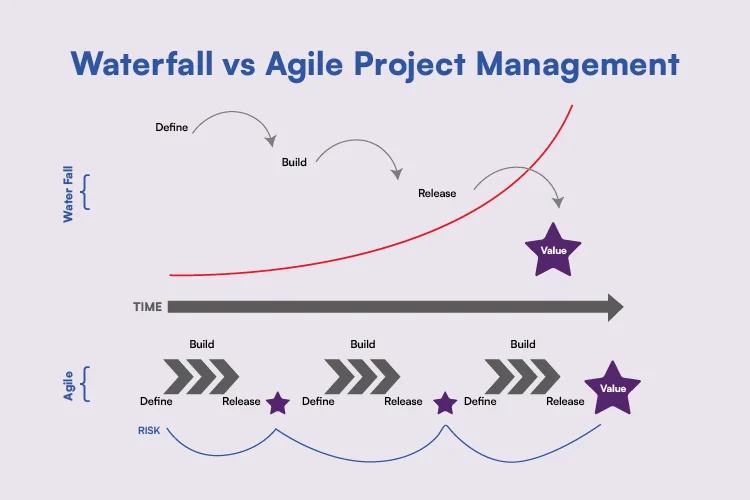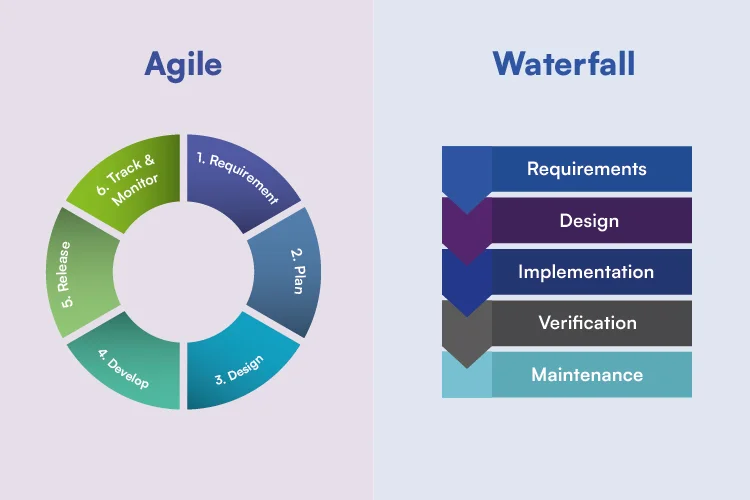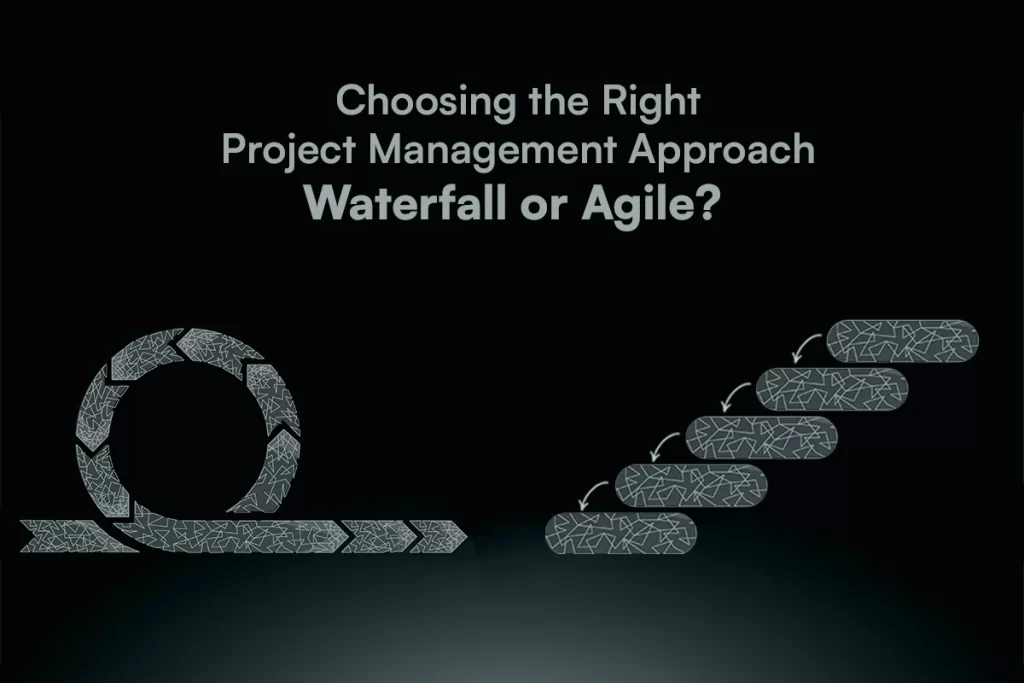Project management methodologies aid in the organization and structure of work processes. They aid in the monitoring of the smooth flow of operations as well as the reduction of errors. Waterfall and Agile are two such approaches that are the most widely used as project management software in organizations and important in the SDLC. However, its application is entirely dependent on the nature of the project. The Waterfall paradigm requires a team to work on project phases sequentially, one after the other, but the Agile allows a team to work on many stages concurrently.
Both the Waterfall and Agile methodologies have advantages and downsides. A software development team can benefit from these two techniques in general.
The approach to choose is determined by the size, kind, and resources of the software outsourcing services organization.
In this blog, we will look closely into the two methodologies comparing Waterfall and Agile processes, as well as the pros and cons of each methodology. So, let’s begin with a short description of Waterfall and Agile approaches.
Waterfall Methodology
Waterfall is reported to have been created and implemented originally as a Process Model. Each step of work in this model must be finished before moving on to the next, and there is no crossover between the phases of this model. The Waterfall model depicts the software development life cycle (SDLC) as a logical, sequential flow of data. This means that any stage of development can begin only after the previous phase has been finished. The stages of this Waterfall model do not cross in any way.
Waterfall guarantees that each phase is completed before proceeding to the next.
Agile Methodology
The methodology is a flexible and iterative strategy that allows teams to quickly adjust to changing project needs and deliver high-quality solutions in less time. In software development, agile is frequently utilized.
Agile is all about collaboration, customer happiness, ongoing improvement, and breaking large projects down into manageable chunks. Agile procedures enable teams to pivot and respond to changing client needs while retaining a high level of flexibility by prioritizing cooperation and communication. The emphasis on continuous improvement means that teams are constantly looking for ways to enhance their processes and offer the best results possible.
Finally, the Agile technique aims to produce better results by taking a more simplified and adaptive approach.
After having a short brief into the two project management frameworks, let’s read about the major differences between Agile and Waterfall, to choose the right methodology for your firm.

Waterfall vs Agile Project Management:
| Agile Methodology | Waterfall Methodology |
| Agile divides the project development lifecycle into sprints. | The software development process is separated into segments. |
| Agile uses an incremental approach. | Waterfall is a sequential design process. |
| Agile methodology is flexible. | It is an organized process that might be rigid at times. |
| It can be thought of as a collection of several projects. | The software can be built as a single project. |
| After basic planning is complete, changes to project development requirements might be made. | Once the project development begins, the requirements cannot be altered. |
| It employs an iterative development approach. The phases of planning, development, prototyping, and software development may exist more than once. | In the waterfall approach, project development steps such as design, development, and testing are completed only once. |
| After each sprint, the test plan is evaluated. | During the testing process, the preplanned test plan is rarely communicated. |
| The specifications may alter and evolve. | This model is appropriate for projects with a consistent set of needs. |
| Testing is carried out concurrently with software development. | After the testing phase comes the building phase. |
| It employs a product mindset in which the software product would meet the needs of end users. | It demonstrates a project mindset and focuses on project completion. |
| In fixed-price circumstances, it would raise the amount of stress. | The risk is lessened since the price of contracts is fixed by obtaining the risk agreement at the outset. |
| It is preferable to work with small, devoted teams that require a great deal of coordination and synchronization. | There is insufficient cooperation and synchronization among team members. |
| It works effectively with non-fixed funding, such as time and supplies. | Before starting a project, a business analyst will compile the requirements. |
| Every day during a project, the product owner and teams prepare requirements. | Any changes to the requirements are difficult to implement. |
| Because projects may be managed by the entire team, project managers are unnecessary. | Because the process is generally simple, a project manager is necessary. |

When to use Agile vs Waterfall?
Waterfall is the ideal choice for reliable projects since it requires extensive preparation at the outset, taking into account all internal and external factors that influence project performance. The reason for being the best choice for working with the external environment is because it is steady and unlikely to alter during the plan, regardless of the project’s size.
However, prior to the introduction of Agile, Waterfall was the preferred approach for external projects. As a result, if you can plan a project ahead of time in a low-risk setting, there’s no reason to split it into numerous sprints to produce value each week.
In contrast, given their unstable and unpredictable character, Agile appears to be a more adaptable method. In other words, if the product vision and associated requirements can change due to external variables such as market dynamics, it is preferable to design and adapt the product utilizing Agile. Agile is also the greatest strategy for ensuring that the project does not spend months in development before showing any results. At the end of each sprint, the product owner will be able to test and approve the finished work.
In changing projects that use checkpoints, a lack of sufficient checkpoints creates risk. Waterfall because it makes resolving potential flaws uncovered at the end of development more complex. As a result, the concept of when to use agile vs waterfall, extra time set aside for project planning does not guarantee that the design and development phases will run smoothly to the end, because most impediments are both unpleasant and unexpected.
Waterfall vs Agile Pros and Cons:
Below are the major Waterfall vs Agile pros and cons in detail, which will help to choose the right waterfall vs agile project management.
Pros of Waterfall:
- Framework: Before beginning the project, the framework establishes a clear knowledge of the timeframe and deliverables. The scope of the project will be determined by the custom software development team and the customers.
- Documentation: To avoid misconceptions, software engineers document each stage of the process.
- Shared Load: The bespoke software development project does not require all your time and attention. Team members focus on different aspects depending on the phase.
- Hands-off Method: Customers can take a hands-off approach with the waterfall technique. There is a requirement till the review session when people set an initial design and project plan.
Cons of Waterfall:
- Less Customer Involvement: A hands-off approach is not necessarily appropriate for every software product. Some clients wish to be more involved in the project’s progress. End-users will be frustrated if there is no framework in place to allow for customer interaction.
- Difficult to Change: The waterfall helps people to follow specific processes and set a timeframe. When these components are in place, it is difficult to make modifications when the development team is working against a deadline. Because it is impossible for clients to have a complete understanding before the process begins, adaptability is a crucial aspect of the bespoke software development process.
- Last-minute Testing Session: There is no time constraint between Waterfall and Agile, which is one of the waterfall method’s downsides. Although the waterfall approach can be beneficial to software development projects, no project has fallen behind schedule. The first 90% of the code, for example, accounts for the first 90% of development time. The remaining 10% of the code accounts for the remaining 90% of development time. As a result, the last testing session will be rushed, resulting in buggy code.
Pros of Agile:
- Involvement of stakeholders: This strategy encourages ongoing contact between development and the customer.
- Flexible Deliverables: Because of its hierarchy of importance, an Agile approach allows stakeholders to establish deliverables. This is exactly what Agile software development technique can do if a customer delivers the fundamental software products before the whole suite.
- Easy to adapt: One of the most significant aspects of Agile development is adaptability. It also has a significant impact on custom software development projects. Some software outsourcing services assist customers in transforming their notions about what they require from a software solution. The software development team can then adjust the scheduled sprints accordingly.
- High-quality user-friendly software: Because clients provide feedback after each sprint, the software development team employs the agile technique. It will result in an easy-to-use software product.
Cons of Agile:
- Commitment: Agile technique works best when the entire bespoke software development team commits to the project. It is difficult for software outsourcing service providers and developers to have a lot going on at the same time.
- High cost and longer time: While time-boxed sprints enable scheduling, employees may fail to complete some deliverables on time. Furthermore, adding additional sprints may incur significant costs.
- Communication: Because Agile necessitates a high level of collaboration, bespoke software development teams must communicate with one another.
Why Methodology should be Used?
You are now aware that each methodology has advantages and disadvantages. Knowing this makes it easier for us to determine how you can use and when to use Agile vs Waterfall approaches in your projects
What is Waterfall Methodology appropriate for?
Waterfall methodology places a high value on meticulous planning and modeling prior to implementation. As a result, it stands to reason that it is not ideal for clients who are unsure of what they anticipate from you. They are also unsuitable for large and complex projects that require extensive client involvement before being released.
Reasons why the Waterfall methodology is appropriate:
- Projects in which you collaborate with other organizations or remote workers (since everything is clear and there is no opportunity for ambiguity).
- Projects with a predetermined scope, timeline, and budget.
- Smaller, more defined, and easier projects.
- Projects with a client who is not present.
What is an Agile approach suitable for?
Agile is essentially a method of delivering a product progressively and iteratively. You’re still using a linear strategy if you only provide your product in increments (or batches) rather than iterations (that is, repeating the process of planning expectations and requirements for each increment). The entire procedure should be repeated for each increment in an Agile methodology to ensure that every adjustment or modification is accounted for in the following increment. In an Agile approach, each increment looks like this.
Reasons why Agile is appropriate:
- Projects in which your business oversees the entire process
- Projects with the potential for changing requirements
- Projects that are larger, ambiguous, and difficult
- Projects involving a client
You should now be familiar with the fundamentals of both the Waterfall and Agile. In the Waterfall and Agile methodologies section, we saw various elements that could be decisive considerations. The distinctions will assist you in selecting the model that is most suited to your project. You can choose the best technique for your project based on the size of the project, the amount of time you have, or the experience of your team. This will allow you to construct the project more efficiently and successfully.




